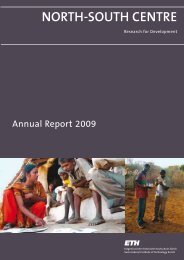Annual Report 2006/07 - ETH - North-South Centre North-South ...
Annual Report 2006/07 - ETH - North-South Centre North-South ...
Annual Report 2006/07 - ETH - North-South Centre North-South ...
You also want an ePaper? Increase the reach of your titles
YUMPU automatically turns print PDFs into web optimized ePapers that Google loves.
Research fellow (Post-doc)David Odongo, ILRI, KenyaSupervisorsClaudia Daubenberger, STI, Basel /Richard Bishop, ILRI, KenyaCollaboratorsGerd Pluschke, STI, Basel /Rinaldo E. Zurbriggen, Pevion Biotech /Evans Taracha, ILRI, KenyaDurationSeptember 2004 – August <strong>2006</strong>Research Fellow Partnership Programme (RFPP)Development of a second generation anti-tick vaccineusing a mimotope-virosome approachThis project pursued a novel approach to synthetic vaccinedesign and delivery by using a virosome strategy with theaim of improving TickGARD, an existing commercial anti-tickvaccine. TickGARD vaccine protects cattle against Boophilusmicroplus and B. decoloratus tick infestation. These ticks are amajor veterinary problem affecting cattle health, causingeconomic losses due to the diseases they transmit and highcosts of control.We identified four immuno-dominant peptide regions representingimmuno-dominant epitopes and recognised by serain TickGARD vaccination. Extended versions of these syntheticpeptide candidates (mimotopes) were synthesised andcoupled to virosomes and their performance was evaluated.These mimotopes produced high tick-gut-binding antibodiesin mice evidenced by immuno-histochemical staining of tickgutsections. One mouse was used to generate a hybridomacell line for monoclonal antibodies binding to tick-gut cellsexpressing the native protein.We determined immunogenicity of the mimotope-virosomeconstructs in cattle. Antibody and cellular immune responsesagainst both the synthetic peptides and the virosomeswere not detected in vaccinated cattle suggesting thatimmunisation was unsuccessful and that virosomes maynot be suitable as antigen delivery system for antigens incattle. However, a group of cattle immunised with theC-terminal end (where three of the immuno-dominantepitopes were located) of the recombinant protein yieldedhigh antibody titres after the second inoculation, and weresubsequently challenged with B. decoloratus ticks. The meanEngorged B. decoloratus adult female ticks are harvested and incubated in order toassess their survival and egg-laying capacity in an anti-tick vaccine experimentweight per individual engorged female tick and meanweight of eggs laid per surviving female adult were significantlyreduced in ticks fed on immunised animals relative tothose fed on control calves.Strategic partnerships with academic and research institutionswere established during the duration of this project.Collectively, these partnerships provide crucial expertise forvaccine development, open future capacity building opportunitiesand will considerably strengthen the capacity ofthe academic institutions to conduct research in tropicalanimal health.49
















